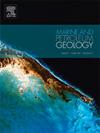快速下沉的上新世奥里诺科河三角洲复合三角洲的保存:定量河流、潮汐和风暴波信号的启示
IF 3.7
2区 地球科学
Q1 GEOSCIENCES, MULTIDISCIPLINARY
引用次数: 0
摘要
尽管在过去的二十年里,在现代三角洲中出现了复合斜形形态的文献,但在地层记录中对这些形态的认识仍然很少。在已确认的古代案例中,已记录了潮汐和波浪主导的复合斜形。我们在特立尼达的上新世奥里诺科-莫鲁加三角洲中发现了一个以河流和波浪为主的复合斜形三角洲。露头表现出横向变化,复合体系的近端(即上游)部分(SSW)保留了波控型和混合影响型三角洲隆起,远端(即下游)部分(NNE)保留了波控型三角洲隆起。岸线砂体厚度为5 ~ 15 m,为砂质粗化向上的单元,通常由上、下游风暴波作用形成的HCS/SCS和波浪波纹砂岩组成。在沉积位置靠近主要供沙源的上游,岸线隆起由上部以河流为主导的河口坝和河道沉积单元上覆下部以混合影响的河口坝和波浪-潮汐影响的河道沉积单元组成。水下砂层厚度为30 ~ 50 m,其特征是由下层厚的、生物扰动的粉砂岩和泥岩,经过层间粉砂岩/泥岩和薄的丘状/沟槽交叉层(HCS/SCS)组合,到偶尔的HCS/SCS混合层,逐渐变粗向上。在这些近端和上游部分的水下浴场有一定的砂质,受波浪作用的影响明显。相比之下,水下斜滩的远端部分是泥泞的,有重复的、频繁的HCS或波浪波纹层薄层,特别是波浪增强的沉积物重力流沉积。因此,莫鲁加组的复合斜形三角洲呈现出一系列河流、潮汐和风暴波信号,以及多种渠道类型。这种可变性提供了一个宝贵的机会来记录河流、潮汐和风暴波过程之间的相互作用,以及由复合斜形三角洲内各种类型的河道驱动的三角洲建设过程。本文章由计算机程序翻译,如有差异,请以英文原文为准。
Preservation of compound delta in the rapidly subsiding Pliocene Orinoco Delta: Insights from quantitative fluvial, tidal and storm-wave signals
Despite the documentation of compound clinoform morphology in modern deltas over the past two decades, there is still a scarce recognition of these in the stratigraphic record. Among the ancient cases that have been recognized, tide- and wave-dominated compound clinoforms have been documented. Here we present a fluvial- and wave-dominated compound clinoform delta in the Pliocene Orinoco Moruga Delta on Trinidad. The outcrops exhibit lateral variation with wave-dominated and mixed-influence deltaic clinothems preserved in the proximal (i.e., upstream) part (SSW) of the compound system and wave-dominated deltaic clinothems in the distal (i.e., downstream) part (NNE). The shoreline clinothems are 5–15 m thick, sandy coarsening-upward units, and they commonly comprise HCS/SCS and wave-rippled sandstones generated by storm wave processes in both upstream and downstream parts. In the upstream part where the deposition location was close to main sediment supply, the shoreline clinothems comprise an upper unit of fluvial-dominated mouth bar and channel deposits overlying a lower unit of mixed-influence mouth bars and wave-to tide-influenced channel deposits. The subaqueous clinothems are 30–50 m thick and are characterized by coarsening-upward units changing from thick, bioturbated siltstones and mudstones at lower levels, through interbedded siltstones/mudstones and thin hummocky/swaley cross-stratified (HCS/SCS) sets, to occasional amalgamated HCS/SCS beds. The subaqueous clinothems in these proximal and upstream parts are somewhat sandy and notably influenced by wave processes. In contrast, the distal parts of the subaqueous clinothems are muddy with repetitive, frequent thin beds of both HCS or wave-rippled beds and especially wave-enhanced sediment gravity flow deposits. The compound clinoform delta in the Moruga Formation thus exhibits a spectrum of fluvial, tidal, and storm-wave signals, along with diverse channel types. This variability provides a valuable opportunity to document the interactions among river, tidal, and storm-wave processes as well as delta building processes driven by the various types of channels within the compound clinoform delta.
求助全文
通过发布文献求助,成功后即可免费获取论文全文。
去求助
来源期刊

Marine and Petroleum Geology
地学-地球科学综合
CiteScore
8.80
自引率
14.30%
发文量
475
审稿时长
63 days
期刊介绍:
Marine and Petroleum Geology is the pre-eminent international forum for the exchange of multidisciplinary concepts, interpretations and techniques for all concerned with marine and petroleum geology in industry, government and academia. Rapid bimonthly publication allows early communications of papers or short communications to the geoscience community.
Marine and Petroleum Geology is essential reading for geologists, geophysicists and explorationists in industry, government and academia working in the following areas: marine geology; basin analysis and evaluation; organic geochemistry; reserve/resource estimation; seismic stratigraphy; thermal models of basic evolution; sedimentary geology; continental margins; geophysical interpretation; structural geology/tectonics; formation evaluation techniques; well logging.
 求助内容:
求助内容: 应助结果提醒方式:
应助结果提醒方式:


